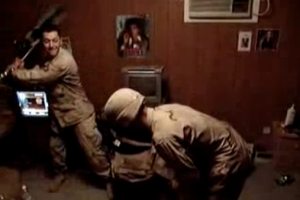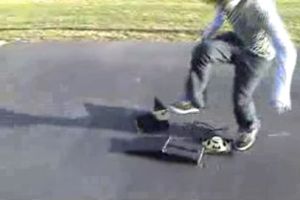I am interested in public space, participation and community. In my art practice and research I explore connections between media technologies and the social contexts in which they operate.
Al Larsen
portfolio
texts
Blood, Ketchup and Pussy Riot: The Performance of Public Protest
Paper presented at Media in Transition 8, MIT (2013)
Fast, Cheap and Out of Control: The Graphic Symbol in Hardcore Punk
Paper published in The Journal of Punk and Post Punk (2012)
Showing and Sharing on a Friday Night (After Work – More Work!):
Real Space Event Series and the Logic of Social Sharing
The paper discusses the dynamics of participation and user-generated content in "sharing events" - such as Pecha Kucha and Dorkbot - in relation to social media platforms. While these event series may function as social support systems for enabling the flexible - and exploitative - labor conditions required of knowledge workers they also represent the possibility of locally-constituted, internationally networked groups that cut across labor status.
Paper presented at Media in Transition 6, MIT (2009)
The Graphic Symbol in Hardcore Punk:
Participation, Collectivity and Hands-On Transmission
An analysis of the simple graphic symbols employed in hardcore punk in relation to the subculture's media ecology and networks of commerce and participation.
Paper presented at PCAS/ACAS (2009)
Selling (Out) the Local Scene: Grunge and Globalization
In this paper I demonstrate how the tensions and contradictions of globalization were embodied in the 1990s youth media culture of "grunge rock."
MFA Thesis (2009)
performance
Warm Not Cold
blog and performances (2006)
Warm Not Cold treated blogging as a form of performance and, in turn, used content from the blog as the basis for performances. Videos, animations and text pieces posted on the blog were used as the backdrop for songs, spoken word pieces and audience participation. The performance of the blog was also a subject of the blog so that Warm Not Cold became a self-documenting project.
While screens are ubiquitous and call for our attention from workstations, laptops and handheld devices, there are many moments when the media is not wholly immersive and the act of watching becomes a social experience, such as when several family members are crowded around one monitor, expectantly waiting for a video to begin streaming. The performance of Warm Not Cold worked to explore the everyday reality of the viewer/screen relationship, ultimately leading the audience away from the screen.
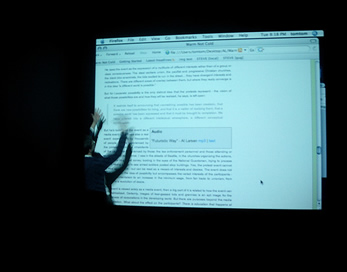
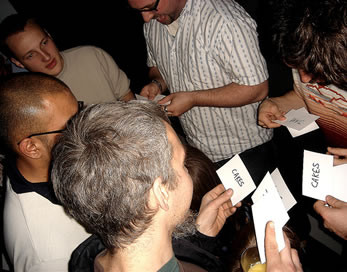
This Could Be The Last Time We Are Here Together
participatory performance event (2008)
This Could Be The Last Time We Are Here Together is a rock-n-roll performance that capitalizes on the power of the stage/amplification apparatus and redirects its energies to the social. The lyrics of the song call on the audience to manifest "a material solution" and a "working model" and are both sung and voiced by a proximity-controlled speech synthesizer built for the performance. During the performance helpers stationed in the audience produce a length of rope and initiate a tug-of-war. After the tug-of-war concludes, the helpers begin swinging the rope, turning the impetus for competition into an invitation to participation. As audience members spontaneously organized themselves to take turns in the jump rope spotlight, the musical performance moved from the center of attention to become a backdrop to the activity in the audience, demonstrating a "working model" of a "material solution."

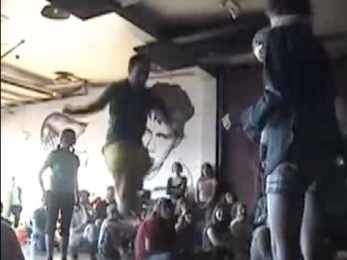 ";
";
Get it Together
performance with video projection (2006)
This was a performance I gave on the last evening of a multi-day festival. For my video "backing band" I edited together and looped short excerpts of different musical performances and events that had occurred on the previous days of the festival.
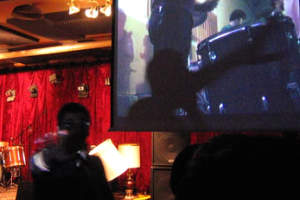
Standing On This Bridge
performance with interactive video projection (2010)
My current work in performance with interactive video projection. The images and text on the screen respond to sound levels and sound patterns in the live performance. The beat of the music advances the images and the lines of text. The screen text creates a narrative from which the live spoken/sung text diverges. Programmed in the Processing development environment.
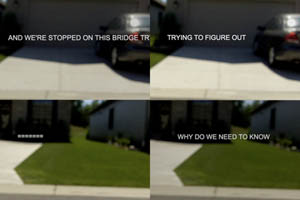
physical computing
Wah Wank
gestural interface to audio signal processing device (2007 - 2008)
The Wah Wank is a guitar effects processing unit that has been modified to be controlled by the gestural movement of the player.
The project is part of a series of speculative effects boxes that explore relationships between technology and embodied performance in popular music.
Using the device is both intuitive and problematic (as it puts unusual physical demands on the player) and highlights the absurd extra-musical gesture in rock music performance while situating it in the Romantic ideal of the physically embodied artist.
Components: Arduino micro-controller, accelerometer, Dunlop Crybaby Wah Wah circuit, aluminum box, programming.
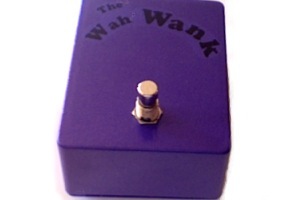
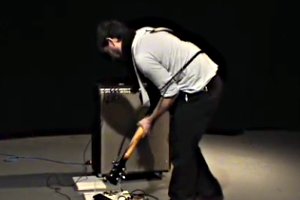
Echoflex
gestural interface to audio signal processing device (2007 - 2008)
Echoflex is an audio delay, or "echo" unit, that has been modified to be controlled by data input from a proximity sensor.
When the user is close to the microphone, the length between echoes is very short - suggesting proximity to the listener - and as the user moves away from the microphone the length increases, suggesting a greater and greater distance.
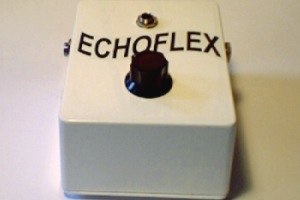
Game Over
stompbox and modified guitar (2007 - 2008)
Game Over is a stompbox for breaking the strings on an electric guitar.
Game Over comments on the commercial industry that relentlessly markets gear while referencing the romantic tradition of symbolic self-destruction within rock performance. Since a destructive intervention on the instrument itself can be taken as the highest form of authenticity within rock performance, a string-breaking stompbox presents a perverse automation and commercialization.
Components: motor, switch circuit, bright orange guitar, aluminum box.
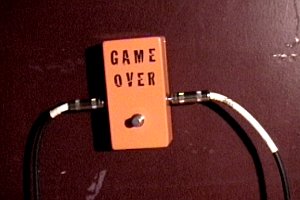
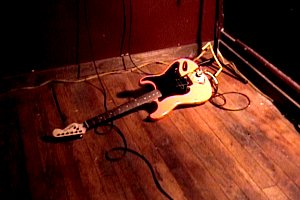
RhythmKid
multi-voice rhythm box and performance tool (2009-2010)
The RhythmKid is a functional rhythm box and synchronized tremolo.
Whereas most rhythm devices produce a pattern to which the musician must then synchronize to, this box allows an instrumentalist to plug in to the box and have the volume of the audio signal modulated in the beat of the rhythm.
As any human chaos or noise becomes folded into the regular pulse of the machine, the project is meant to bring the embodied, fallible human and the rhythmically precise machine into closer alignment.
Components: Arduino micro-controller, programming, custom circuitry, aluminum box.
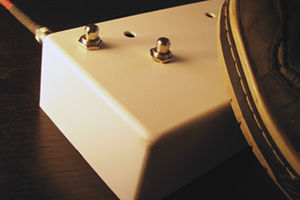
Heavy Elements
sound installation (2009-2010)
electronics, water, fire, found objects
Exhibited at Stimulus, Hallwalls Contemporary Art Center, Buffalo, NY (2010) and Narrow Waters, What the Heck Fest, Anacortes, WA (2009).
The project sets up a simple system in which the elements stimulate and effect each other. The piece is meant to suggest the animated but ultimately unsustainable relationships between the natural world, combustion and manufacturing that are the legacy of the 20th century.
In a darkened space a single candle burns, casting light onto an empty disposable water bottle that hangs from a thread. Behind the water bottle is a simple electronic circuit with wires, chip and battery exposed. The chip is connected to a large guitar amplifier which projects a loud square wave tone generated by the chip. As the light - refracted through the contours of the clear plastic bottle and the dregs of water inside - plays over the surface of a photoresistor on the chip, the tone varies in pitch. The heat from the candle flame causes the bottle to spin slightly on its thread. The spinning affects the play of light on the photoresistor and the air vibration from the amplifier speaker causes the flame to jump and flicker.
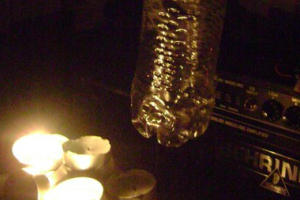
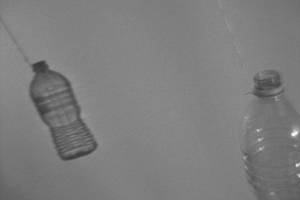
event-based
public discussion events
public discussion events (2009)
A series of loosely-moderated roundtable gatherings to discuss art in the context of community organizing, emerging economic models for artists and the relationship of theory to practice.
DIY
The Public School, Los Angeles, CA
(organized with Charlie Roderick)
Over, Up, Down, or Through?
Sugar City, Buffalo, NY
(organized with Melissa Moore)
An Open Discussion on Making It Happen
Croatian Hall, Anacortes, WA
(organized with Aimee Buyea and Kevin Erickson)
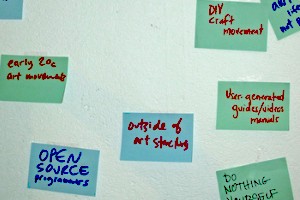
The Friendship Trail
public space performance event (2001)
collaboration with Phil Elvrum
In conjunction with YoYo a GoGo, an international festival of underground music and culture, Phil Elvrum and I organized a "trail" of short performances in the downtown core of Olympia, Washington and led an audience from station to station. Performers were set up in unlikely places: a loud band in the branches of a tree, a rapper performing from inside his car; a puppet show in the entryway of a strorefront.
The event was meant as a critical intervention in the festival format. Because the main festival events took place in a large theater venue, we wanted to create an event that broke out of the theater/stage/amplification apparatus and encouraged exchange between strangers while affirming the origins of the underground music culture celebrated by the festival in marginal, "unofficial" performance spaces.
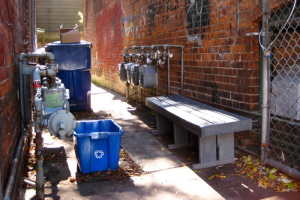
The Powerlines Are Down
environmental audio event (2002)
sound piece for six car stereo systems in motion.
The Powerlines Are Down uses window-rattling automobile sound systems to create a sound environment in public space. The composition consists of six channels of audio distributed among the automobiles. During the performance the automobiles drive a prescribed route, crossing and following each other. With the audio sources moving through space, and the sound bouncing off buildings and mixing with engine sounds and the evening cries of seagulls the performance turns the sound of the city into a subject for reflection.
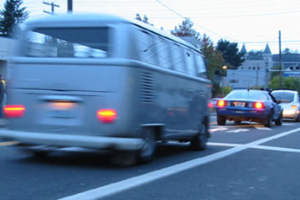
Lights! Cameras! Cookies!
participatory video event (2007)
collaboration with Clyde Petersen
Within the context of What the Heck Fest, an alternative art and music festival, Clyde Petersen and I offered a one-day youth video workshop. The resulting video, titled Good, Evil & Trash, was collaboratively conceptualized, scripted and scored by the players and was screened that evening at the concluding show of the festival. We served as facilitators, project managers and video editors and the kids created and directed the content.
Lights! Cameras! Cookies! was intended as an intervention into the fabric of the festival format. By working with and enabling the creative expression of younger kids - mostly the children of perfromers and audience members - we sought to expand the notions of participatory culture and inclusivity that inform the festival.
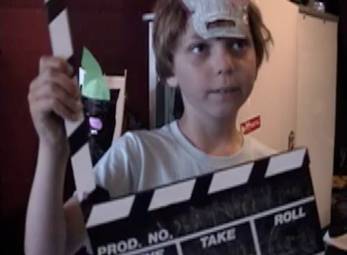
video
Consider Me Your Neighbor
digital video (2010)
Single channel experimental narrative video on the nature of work, friendship and trust in the networked environment. The protagonists are integrated into the networked information economy - wi-fi, databases and mobile phones are their tools - but seemingly excluded from its profits, conducting business from parking lots, dingy hallways, or out of their cars. As they negotiate deals and set shipping containers in motion, the free flow of information, capital and goods across borders is contrasted against the desolate "non-places" the protagonists inhabit.
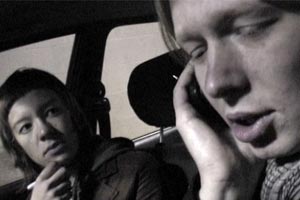
Ritual Sacrifice
multi-channel video installation (2008)
Video installation compiling clips culled from online video sharing sites that depict amateur musicians performing acts of destruction for the camera. Starting from Jacques Attali's statement in Noise: The Political Economy of Music that "the musician is an integral part of the sacrifice process, a channeler of violence," the installation highlights the symbolic violence of the ritualized destruction of musical instruments.
